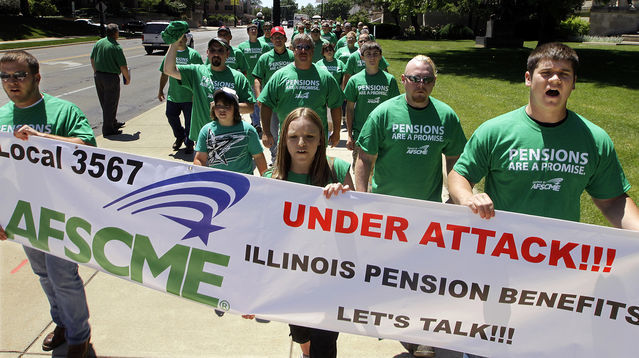When he describes a fundamental truth of pension accounting universally accepted by economists, Andrew Biggs of the American Enterprise Institute achieves an elegant explanation: “A guaranteed liability must be discounted at a risk-free rate.”
But that truth is ugly when it reveals the hidden tax increases and service cuts likely to be inflicted on future generations by deceptive public pension accounting today.
Truth is an abyss $4.6 trillion deep and getting deeper every day, according to Biggs’s calculations based on latest available data.
Dicey Discount Assumptions
Pensions determine how much to invest now to pay future benefits earned each year through discounting the future obligation by an assumed rate of return on investments over the years before an employee retires. That discount rate is the most important of seven assumptions pension actuaries use.
The higher the discount rate assumption, the less a government must contribute now. Current U.S. public pension accounting guidelines allow politicians to set high discount rates that let them put less money into pension fund investments.
Biggs notes in his study, commissioned by State Budget Solutions, “U.S. public employee pensions are an outlier in how they calculate their funding health” when compared to public plans around the world, a fact confirmed in a recent comparative study by economists at Notre Dame and Maastricht universities that called for “drastic reform” of U.S. public pension policy.
Biggs says advocates of the status quo nonetheless contend public plans are different because governments cannot cease to exist as private businesses can, so their pension benefits truly are guaranteed.
Biggs rebuts that argument.
Counter to Economic Reasoning
“First, the fact that governments cannot go out of business implies that government pension benefits are more likely to be paid than private pensions; under standard economic reasoning, this justifies a lower rather than higher discount rate.
“Second, government’s longevity does not make costs go away; instead, it implies that rather than defaulting on pension liabilities … the government shifts the cost of these liabilities to future taxpayers,” he wrote.
According to Bob Williams, president of State Budget Solutions, “Failing to understand the scope of the pension crisis sets taxpayers up for a bigger catastrophe in the future.”
Williams said he commissioned Biggs to do the study because, “public pensions are deteriorating so rapidly, and there is such a time lag in reporting official data that we had to do something, or it will be too late.”
He added, “Without immediate government action, states, counties, cities, and towns all over America will go bankrupt.”
Truth Avoidance
He said the first step politicians must take is to admit the size of the problem, something current pension accounting allows them to avoid.
The second step is to halt the accrual of liabilities and set in place irrevocable amortization of the existing unfunded liability. For municipalities, the alternative is bankruptcy. For states, it is perpetual debt.
“We have suggestions for specific solutions that can resolve this crisis over time,” Williams said. “But denial and delay feed it like an untreated cancer. For too many states and municipalities, it soon will be too late.”
The Pew Center on the States this year in its “Widening Gap” update using official assumptions set the unfunded pension liability at $757 billion as of Fiscal Year 2010. Official discount rate assumptions are in the 7-8 percent range. To achieve those returns over the next 30 years, pension investments would have to gain 9-10 percent every year and there could be no market downturns over that period.
Economists Robert Novy-Marx, University of Rochester, and Joshua Rauh, now of Stanford University, recently updated their “Revenue Demands of Public Employee Pension Promises” study for the National Bureau of Economic Research and found the unfunded liability to be $4.4 trillion as of 2010.
$1,385 Per Household Tax Increase
“We calculate increases in contributions required to achieve full funding of state and local pension systems in the U.S. over 30 years. Without policy changes, contributions must increase by a factor of 2.5, reaching 14.1% of the total own-revenue generated by state and local governments,” they wrote. “This represents a tax increase of $1,385 per household per year,” on top of all other rate hikes, new taxes, and increased revenue from economic growth.
As of midyear 2011, the Center for Retirement Research at Boston College put the official unfunded liability at $885 billion. Applying universally accepted economics standards to those data, Biggs calculates the true debt at $4.6 trillion, more than five times the official estimate despite pension reform measures in 43 states.
He writes, “While state and local governments around the country have enacted reforms to public sector pension plans, including contribution increases, less generous benefits for newly hired employees, and in some cases reductions in cost of living adjustments for current beneficiaries, accurate accounting of public employee pension liabilities shows that elected officials must do much more to make these plans financially sustainable.…
“Unfortunately, these reforms won’t come close to restoring plans to true full funding, because current accounting conventions systematically understate pensions’ benefit liabilities and thereby overstate their financial health. Current pension accounting standards also encourage pensions to take excessive investment risk,” he concludes.
Frank Keegan ([email protected]) is editor of Statebudgetsolutions.org, a project of sunshinereview.org.
Internet Info
“Public Sector Pensions: How Well Funded Are They Really?” Andrew G. Biggs: http://www.statebudgetsolutions.org/publications/detail/public-sector-pensions-how-well-funded-are-they-really




